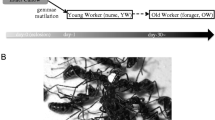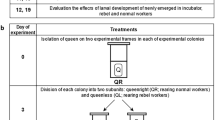Summary
Colonies and smaller social groups of honeybees (Apis mellifera carnica L.) show distinct free-running circadian rhythms similar to that of individual organisms. The workers of a colony synchronize their individual rhythms to one overall group rhythm. Caste plays an important role in this synchronization process. Queens were introduced into worker groups which were entrained to a phase-shifted light/dark cycle. The introduction of the queen caused a shift in the free-running phase under constant dark conditions. Single introduced workers had no effect on the free-running rhythms. This indicates that the queen plays an important role in the synchronization of circadian rhythms of honeybee colonies.
Similar content being viewed by others
References
Beier W (1968) Beeinflußung der inneren Uhr der Bienen durch Phasenverschiebung des Licht-Dunkel-Zeitgebers. Z Bienenforsch 9:356–378
Bovet J, Oertli EF (1974) Free running circadian activity rhythms in free living beaver (Castor canadensis). J Comp Physiol 92:1–10
Crewe RM (1982) Compositional variability: the key to the social signals produced by honey bee mandibular glands. In: Breed MD, Michener CD, Evans HE (eds) The biology of social insects. Westview Press, Boulder, CO, pp 318–322
Enright T (1981) Data analysis. In: Aschoff J (ed) Handbook of behavioral neurobiology, vol 4. Biological rhythms. Plenum Press, New York, pp 21–39
Forel AH (1910) Das Sinnesleben der Insekten. Ernst Reinhardt Verlag, Munich
Frisch B (1984) Circadian rhythms of honey bees. Apidologie 15:278–280
Frisch B, Aschoff J (1987) Circadian activity in honeybees: entrainment by feeding cycles. Physiol Entomol 12:41–49
Frisch B, Koeniger N (1992) Mutual synchronization of the activity rhythms of honeybees within a colony. Behav Ecol Sociobiol (in press)
Gwinner E (1966) Entrainment of circadian rhythm in birds by species specific song cycles (Aves, Fringillidae: Carduelis spinus, Serinus serinus). Experientia 22:765
Hammann E (1957) Wer hat die Initiative bei den Ausflügen der Königin, die Königin oder die Arbeitsbienen? Insectes Soc 4:91–106
Kaiser W, Steiner-Kaiser J (1983) Neuronal correlates of sleep, wakefulness and arousal in a diurnal insect. Nature (London) 301:707–709
Kleber I (1935) Hat das Zeitgedachtnis der Bienen biologische Bedeutung? Z Vergl Physiol 22:221–262
Loher W (1979) The effect of male calling on female locomotor activity of Theleogryllus commodus. Behav Ecol Sociobiol 5:383–390
Marimuthu G, Subbaraj R, Chandrasekaran MK (1978) Social syncronization of the activity rhythm in a cave-dwelling insectivorous bat. Naturwissenschaften 65:600
Marimuthu G, Rajan S, Chandrasekaran MK (1981) Social entrainment of the circadian rhythm in the flight activity of the microchiropteran bat Hipposideros speoris. Behav Ecol Sociobiol 8:147–150
Medugorac I, Lindauer M (1967) Das Zeitgedachtnis der Bienen unter dem Einfluß von Narkose und sozialen Zeitgebern. Z Vergl Physiol 55:450–474
Menaker M, Eskin A (1966) Entrainment of circadian rhythms by sound in Passer domesticus. Science 154:1579–1581
Moore D, Rankin MA (1983) Diurnal changes in the accuracy of the honeybee foraging rhythm. Biol Bull Mar Biol Lab Woods Hole 164:471–482
Moore D, Rankin MA (1985) Circadian locomotor rhythms in individual honeybees. Physiol Entomol 10:191–197
Moore D, Siegfried D, Wilson R, Rankin MA (1989) The influence of time of day on the foraging behavior of the honeybee, Apis mellifera. J Biol Rhythms 4:305–325
Moritz RFA, Crewe RM (1988) Reaction of honeybee workers (Apis mellifera) to fatty acids in queen signals. Apidologie 19:333–342
Praagh JP van (1972) Towards a controlled environment room suitable for normal colony life in honeybees. 1. Description and general observations. J Apic Res 11:77–87
Roelofs WL (1978) Chemical control of insects by pheromones. In: Rockstein M (ed) Biochemistry of insects. Academic Press, New York, pp 419–464
Ruttner F (1980) Königinnenzucht. Apimodia, Bucharest
Seeley T (1979) Queen substance dispersal by messenger workers in honeybee colonies. Behav Ecol Sociobiol 5:391–415
Southwick EE, Moritz RFA (1987) Social synchronization of circadian rhythms of metabolism in honeybees (Apis mellifera). Physiol Entomol 12:209–212
Spangler HG (1972) Daily activity rhythms of individual worker and drone honeybees. Ann Entomol Soc Am 65:1073–1075
Visvanathan N, Chandrasekaran MK (1984) Mother mouse sets the circadian clock of pups. Proc Indian Acad Sci (Anim Sci) 93:235–241
Visvanathan N, Chandrasekaran MK (1988) Limits of maternal entrainment of the activity rhythm in the field mouse Mus booduga. J Comp Physiol (A) 163:237–242
Author information
Authors and Affiliations
Rights and permissions
About this article
Cite this article
Moritz, R.F., Sakofski, F. The role of the queen in circadian rhythms of honeybees (Apis mellifera L.). Behav Ecol Sociobiol 29, 361–365 (1991). https://doi.org/10.1007/BF00165961
Received:
Accepted:
Issue Date:
DOI: https://doi.org/10.1007/BF00165961




